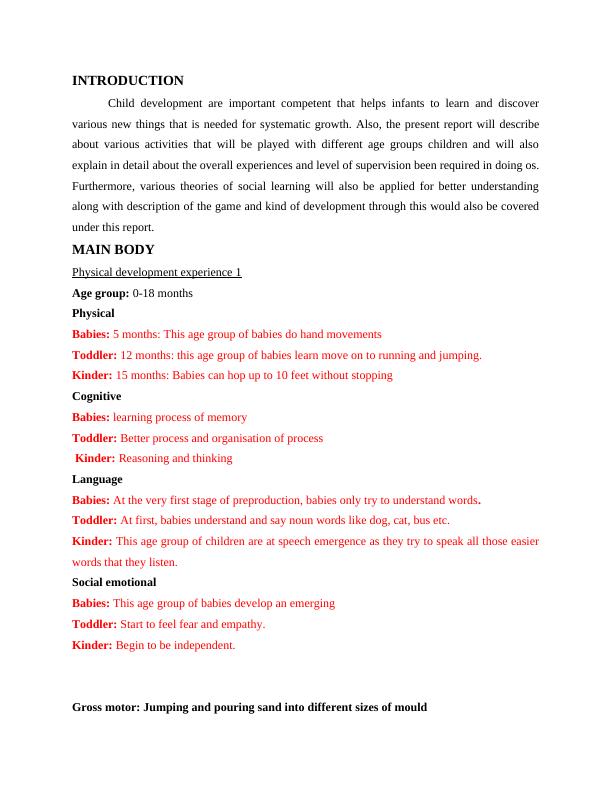Physical Development Experiences for Children of Different Age Groups
Added on 2023-06-07
13 Pages3094 Words120 Views
Resource Folder

Table of Contents
INTRODUCTION...........................................................................................................................3
MAIN BODY..................................................................................................................................3
Physical development experience 1.............................................................................................3
Physical development experience 2.............................................................................................5
Physical development experience 3.............................................................................................7
Physical development experience 4.............................................................................................9
CONCLUSION..............................................................................................................................11
REFERENCES................................................................................................................................1
INTRODUCTION...........................................................................................................................3
MAIN BODY..................................................................................................................................3
Physical development experience 1.............................................................................................3
Physical development experience 2.............................................................................................5
Physical development experience 3.............................................................................................7
Physical development experience 4.............................................................................................9
CONCLUSION..............................................................................................................................11
REFERENCES................................................................................................................................1

INTRODUCTION
Child development are important competent that helps infants to learn and discover
various new things that is needed for systematic growth. Also, the present report will describe
about various activities that will be played with different age groups children and will also
explain in detail about the overall experiences and level of supervision been required in doing os.
Furthermore, various theories of social learning will also be applied for better understanding
along with description of the game and kind of development through this would also be covered
under this report.
MAIN BODY
Physical development experience 1
Age group: 0-18 months
Physical
Babies: 5 months: This age group of babies do hand movements
Toddler: 12 months: this age group of babies learn move on to running and jumping.
Kinder: 15 months: Babies can hop up to 10 feet without stopping
Cognitive
Babies: learning process of memory
Toddler: Better process and organisation of process
Kinder: Reasoning and thinking
Language
Babies: At the very first stage of preproduction, babies only try to understand words.
Toddler: At first, babies understand and say noun words like dog, cat, bus etc.
Kinder: This age group of children are at speech emergence as they try to speak all those easier
words that they listen.
Social emotional
Babies: This age group of babies develop an emerging
Toddler: Start to feel fear and empathy.
Kinder: Begin to be independent.
Gross motor: Jumping and pouring sand into different sizes of mould
Child development are important competent that helps infants to learn and discover
various new things that is needed for systematic growth. Also, the present report will describe
about various activities that will be played with different age groups children and will also
explain in detail about the overall experiences and level of supervision been required in doing os.
Furthermore, various theories of social learning will also be applied for better understanding
along with description of the game and kind of development through this would also be covered
under this report.
MAIN BODY
Physical development experience 1
Age group: 0-18 months
Physical
Babies: 5 months: This age group of babies do hand movements
Toddler: 12 months: this age group of babies learn move on to running and jumping.
Kinder: 15 months: Babies can hop up to 10 feet without stopping
Cognitive
Babies: learning process of memory
Toddler: Better process and organisation of process
Kinder: Reasoning and thinking
Language
Babies: At the very first stage of preproduction, babies only try to understand words.
Toddler: At first, babies understand and say noun words like dog, cat, bus etc.
Kinder: This age group of children are at speech emergence as they try to speak all those easier
words that they listen.
Social emotional
Babies: This age group of babies develop an emerging
Toddler: Start to feel fear and empathy.
Kinder: Begin to be independent.
Gross motor: Jumping and pouring sand into different sizes of mould

Resources required:
Different size of mould and sand.
Different shapes of mould
Large area
Stages of play
Solitary and unoccupied
Unoccupied play in which babies make a lot of movements with legs, hands.
Solitary play in which this age group of kids play alone with toys and they enjoy while
someone make them play
Number of children involved in this experience: 12 students or 3 groups of 4 members.
Level of supervision required
0-18 months of kids are at the highest risk of injury as at this stage they learn to walk,
scrawl and stand up. So, there is requirement of constant as well as close supervision
How the activity will be presented to children:
There will be different sizes of moulds and kids will be asked to pour sand or imitate
their teachers or parents. This age group of people often do all those things that they see around
their surroundings. Also, kids will be observed if they are taking high jumps without supporting
or supporting.
Extension to the activity
Continuous support
Desired shapes of mould will be given
Intentions and learning goal
The main goal of this sensory motor based experience play is to increase cognitive skills
of kids.
To increase their concentration and balance.
Additional support
Symbolic play is one of the best ways by which children of this age group can overcome their
impulsiveness. It can develop their thought out behaviour that will help them out in developing
cognitive functions. In addition, it can be said that it is the first ladder to numeracy and literacy
so, on the basis of this, it can be said that children can learn the way of adapting new things.
EYLF outcomes:
Different size of mould and sand.
Different shapes of mould
Large area
Stages of play
Solitary and unoccupied
Unoccupied play in which babies make a lot of movements with legs, hands.
Solitary play in which this age group of kids play alone with toys and they enjoy while
someone make them play
Number of children involved in this experience: 12 students or 3 groups of 4 members.
Level of supervision required
0-18 months of kids are at the highest risk of injury as at this stage they learn to walk,
scrawl and stand up. So, there is requirement of constant as well as close supervision
How the activity will be presented to children:
There will be different sizes of moulds and kids will be asked to pour sand or imitate
their teachers or parents. This age group of people often do all those things that they see around
their surroundings. Also, kids will be observed if they are taking high jumps without supporting
or supporting.
Extension to the activity
Continuous support
Desired shapes of mould will be given
Intentions and learning goal
The main goal of this sensory motor based experience play is to increase cognitive skills
of kids.
To increase their concentration and balance.
Additional support
Symbolic play is one of the best ways by which children of this age group can overcome their
impulsiveness. It can develop their thought out behaviour that will help them out in developing
cognitive functions. In addition, it can be said that it is the first ladder to numeracy and literacy
so, on the basis of this, it can be said that children can learn the way of adapting new things.
EYLF outcomes:

End of preview
Want to access all the pages? Upload your documents or become a member.
Related Documents
Child Development Activities for Different Age Groupslg...
|13
|3256
|412
Analysis of Development Through Children’s Toys.lg...
|6
|1131
|12
Children Development & Learninglg...
|20
|5109
|66
Sequence of Development and the Rate of Developmentlg...
|7
|1486
|388
Portfolio of Mathematics Projectslg...
|11
|2690
|226
JANUARY2020 - Early Childhood Learninglg...
|9
|1123
|16